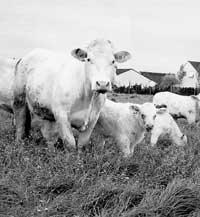BSE does not spread to sheep
2000/08/10 Irazabalbeitia, Inaki - kimikaria eta zientzia-dibulgatzaileaElhuyar Fundazioa
‘Nature’ launches study on the relationship between ‘scrapie’ and mad cow disease
We talk about bovine spongiform encephalopathy (BSE), or mad cow disease, when in the mid-1990s it was discovered that the consumption of cattle with this disease generated Creutzfelt-Jakob lethal disease (vCJD). In addition to the deaths of thousands of cattle, the European Union banned Britain's beef exports to prevent the disease from spreading to continental Europe.
Political, economic and scientific controversies have not failed to take action against this evil without remedy.
On the other hand, ovine spongiform encephalopathy or scrapie sheep disease is widespread among European sheep, endemic in Britain for 200 years. The disease is also spreading in the flocks of Euskal Herria. It is quite frequent among the sheep of the Northern Basque Country and the cases detected in Napari and Tafalla are still discussed.
Similar symptoms
BSE and scrapie also have very similar symptoms. There is therefore great concern among health officials about the possibility that cattle may contaminate sheep when grazed together. If this happens, a vCJD epidemic could occur in humans. Health officials are concerned. In fact, some experimental studies conducted in 1993 detected the possibility of infecting BSE sheep. In case of discharge, BSE cases have not yet been detected in pasture-bred sheep. However, this does not mean that it has not occurred, since the symptoms of both diseases are similar and may be misdiagnosed as scrapie.
B. Mike The group led by Gravenor will publish tomorrow in the journal Nature a number in which there does not seem to have been an epidemic of BSE among the British sheep. A statistical study has been used to reach this conclusion. The number of scrapie cases occurred in more than 7,000 cattle ranchers between 1962 and 1998 has been analyzed.
Although the incidence of scrapie has increased slightly in the last thirty years, growth has been constant. Thus, if the incidence of annual scrapie and the incidence of BSE are included in a graph, there are no peaks in the incidence of scrapie when the BSE epidemic has occurred, either before or after.
No circular confirmation
If at a time when the BSE epidemic was in full boil the number of scrapie cases would have increased a lot (this would look like a spike in the chart), it would mean that it would be related to BSE and scrapie, with all the risks it might have.
The results of the study have not been conclusive and the researchers themselves have not made a circular estimate: "The representative epidemic of BSE has hardly occurred in the sheep population," they literally explain in the Nature article.

Gai honi buruzko eduki gehiago
Elhuyarrek garatutako teknologia





